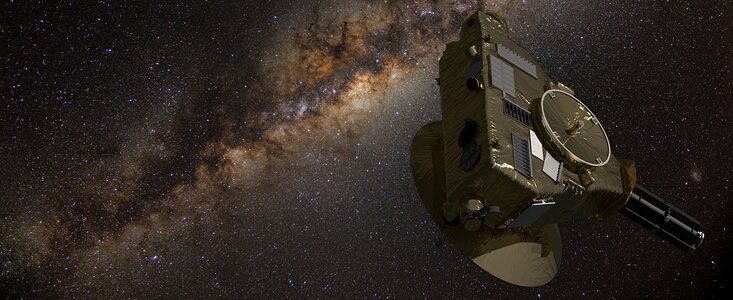NOIRLab Scientist Finds Explanation for Universe’s Mysterious Background Light
Improved measurements with NASA’s New Horizons reveal that the Milky Way’s diffuse light is why the Universe seemed brighter than expected
28 August 2024
Just how dark is deep space? In 2021 a team of astronomers, including Tod Lauer of the U.S. National Science Foundation-funded NSF NOIRLab, attempted to answer this long standing question by tapping into the capabilities and distant position of NASA’s New Horizons spacecraft [1], which allowed them to make the most precise, direct measurements ever of the total amount of light the Universe generates. The results surprisingly showed that the Universe was brighter than expected, and the origin of the mysterious ‘extra light’ became the question. Now, thanks to new and improved data from New Horizons, the team [2] has determined that this extra light was actually a consequence of contaminating foreground light.
More than 18 years after launch and nine years after its historic exploration of Pluto, New Horizons is more than 7.3 billion kilometers (5.4 billion miles) from Earth, in a region of the Solar System far enough from the Sun to offer the darkest skies available to any existing telescope. Its position also provides a unique vantage point from which to measure the overall brightness of the distant Universe, known as the cosmic optical background (COB) — the visible equivalent of the well-known cosmic microwave background.
To acquire their initial brightness measurements in 2021, the team conducted a test COB observation run with New Horizons using its Long Range Reconnaissance Imager (LORRI). Using a small selection of images they measured how much light LORRI captured while pointing out into the depths of the cosmos, and their results left some unanswered questions. They found that only half of the measured COB signal could be attributed to the light generated by all of the galaxies in the Universe. However, this implied that the COB also includes a component of light of unknown origin. The team postulated that this extra light could be originating from galaxies too faint to have yet been detected, or even rogue stars populating intergalactic space.
To identify where exactly this light is coming from the team conducted another run of COB observations with New Horizons’ LORRI in 2023. But this time they analyzed a much larger portion of the sky and supplemented their observations with data from the European Space Agency’s Planck mission, which allowed them to correct for the diffuse scatter of light produced by dust in the Milky Way and scattered starlight from bright stars outside of LORRI’s field of view.
This was a critical improvement to the observation strategy, and the new measurements reveal that once the contaminating sources are removed, the intensity of light coming from the distant Universe is almost exactly what you’d expect to get from all the stars in all the galaxies beyond our Milky Way.
“There is no unknown source of light on top of that,” says Lauer, co-author of the paper presenting these results in the Astrophysical Journal. “We’ve searched the space between galaxies, but find darkness there and nothing more.”
This finding demonstrates a key element to conducting science — improving methods to get more accurate results. It also brings closure to astronomers’ long standing question of how bright space is. It turns out space is as bright as we would expect it to be from the light generated by all the galaxies that have ever formed in the Universe over the last 12 billion years.
Notes
[1] New Horizons is a NASA space probe designed to explore the outer Solar System, particularly Pluto. Launched in 2006, it completed its Pluto flyby in 2015 and is now on an extended voyage through the Kuiper Belt. Amongst its various scientific instruments, New Horizons is equipped with a small 20-centimeter (8-inch) telescope — which proved to be key for this research.
[2] This investigation was conducted by the New Horizons science team, led by Marc Postman, astronomer at the Space Telescope Science Institute (STScI) and Tod Lauer of NSF NOIRLab.
More information
NSF NOIRLab (U.S. National Science Foundation National Optical-Infrared Astronomy Research Laboratory), the U.S. center for ground-based optical-infrared astronomy, operates the International Gemini Observatory (a facility of NSF, NRC–Canada, ANID–Chile, MCTIC–Brazil, MINCyT–Argentina, and KASI–Republic of Korea), Kitt Peak National Observatory (KPNO), Cerro Tololo Inter-American Observatory (CTIO), the Community Science and Data Center (CSDC), and Vera C. Rubin Observatory (operated in cooperation with the Department of Energy’s SLAC National Accelerator Laboratory). It is managed by the Association of Universities for Research in Astronomy (AURA) under a cooperative agreement with NSF and is headquartered in Tucson, Arizona. The astronomical community is honored to have the opportunity to conduct astronomical research on I’oligam Du’ag (Kitt Peak) in Arizona, on Maunakea in Hawai‘i, and on Cerro Tololo and Cerro Pachón in Chile. We recognize and acknowledge the very significant cultural role and reverence that these sites have to the Tohono O’odham Nation, to the Native Hawaiian community, and to the local communities in Chile, respectively.
Links
Contacts
Tod Lauer
NSF NOIRLab
Email: tod.lauer@noirlab.edu
Josie Fenske
Jr. Public Information Officer
NSF NOIRLab
Email: josie.fenske@noirlab.edu


